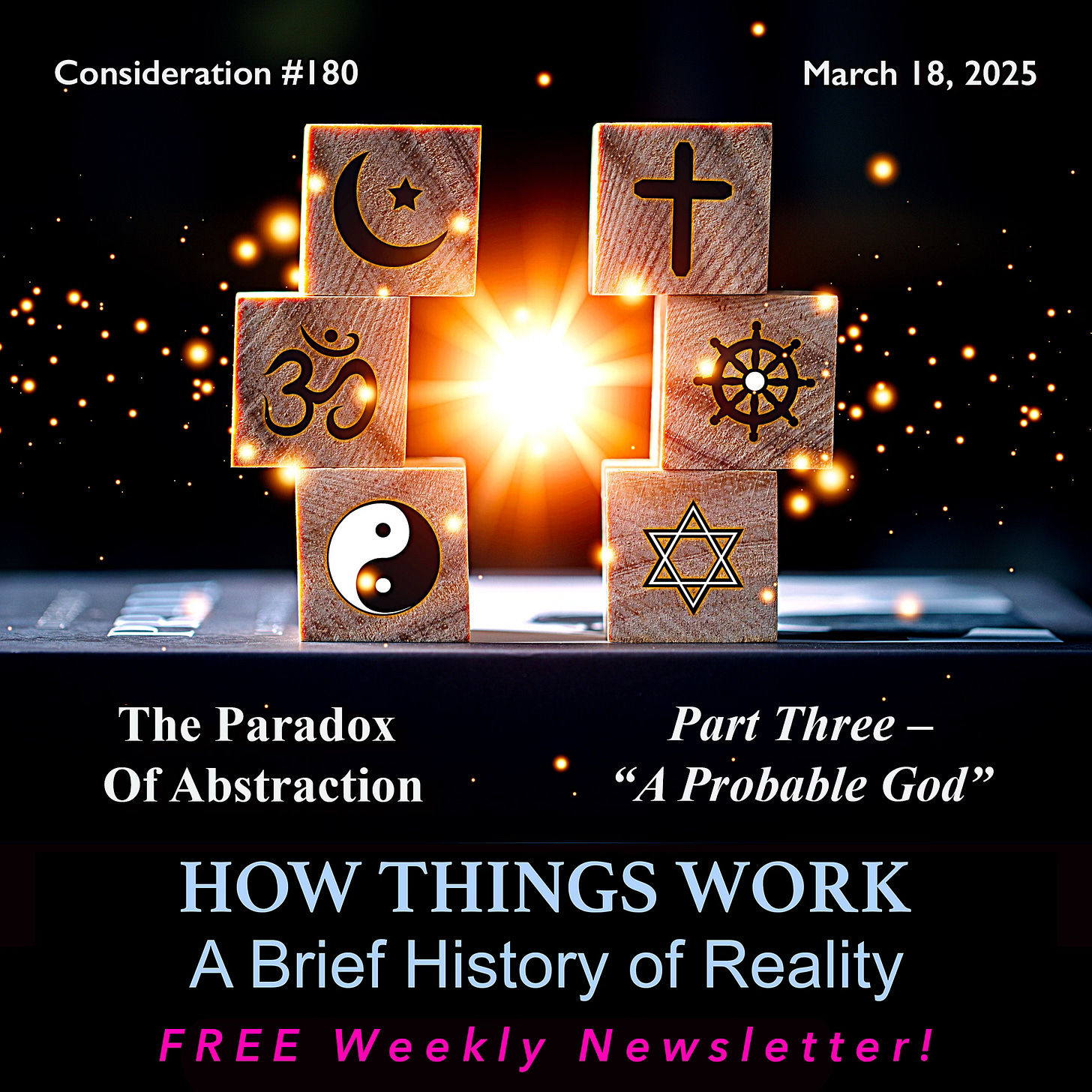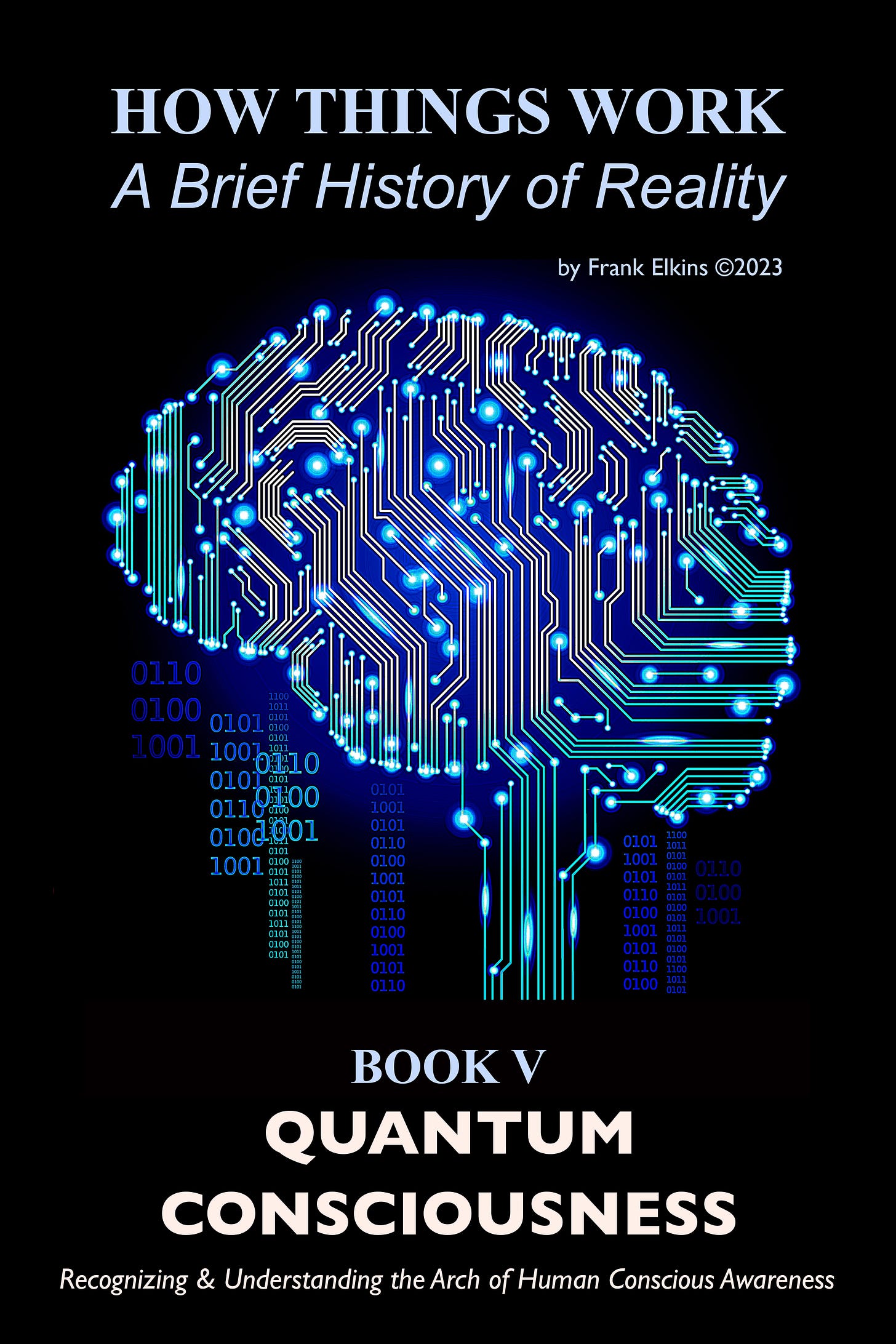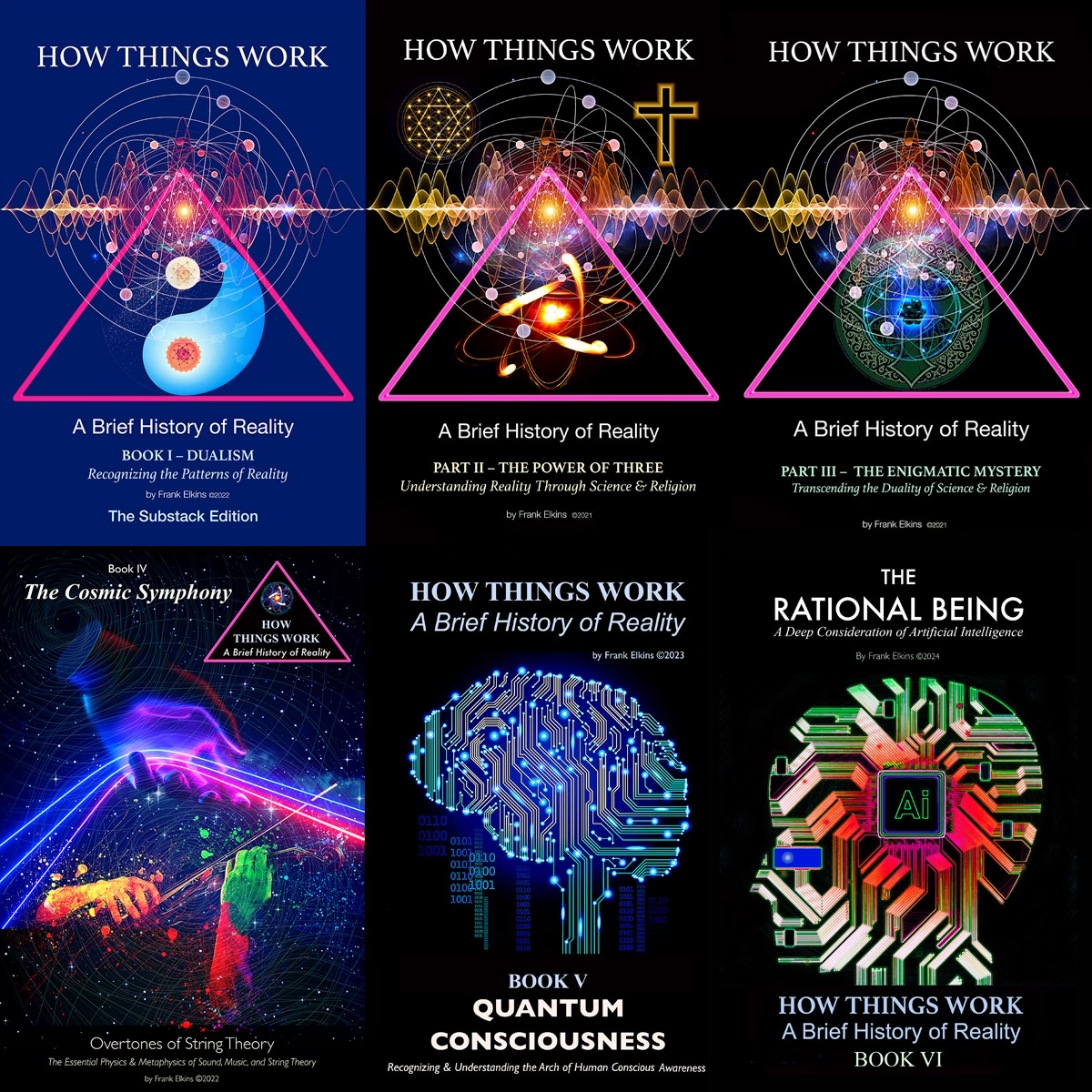The Paradox of Abstraction: Part Three – A Probable God
BOOK III: The Enigmatic Mystery (Science & Religion) – Consideration #180
Be a part of the Conversation!
Tuesday March 18, 2025
“People think of science as rolling back the mystery of God. I look at science as slowly creeping toward the mystery of God.”
– Allan Hamilton
PREFACE
Welcome Everybody!
Ironically, although religions are often known for their dogmatic disagreement regarding their interpretation of truth, the one truth that they all agree on is that the ultimate truth is indefinable. There is no way to define an infinite being, or an infinite state of being. In the West this infinite being is generally referred to as God. The infinite state of being is generally referred to as rationalism. They exist in a rational dimension beyond our physical reality and empirical understanding.
In the Biblical tradition it is foolish to think that we, as human beings, can completely understand God. God exists beyond the physical laws of the universe which include space and time. Therefore, we cannot know or define this infinite and limitless Being. It is foolishness to attempt it.
"Can you fathom the mysteries of God? Can you probe the limits of the Almighty?"
– Job 11:7
“‘For my thoughts are not your thoughts,
neither are your ways my ways,’
declares the Lord.‘As the heavens are higher than the earth,
so are my ways higher than your ways
and my thoughts than your thoughts.’”– Isaiah 55:8-9
"Oh, the depth of the riches both of the wisdom and knowledge of God! How unsearchable are his judgments and how inscrutable his ways!"
– Romans 11:33
The third Abrahamic religion, Islam, demonstrates a similar understanding related to the indefinable nature of Allah, or God, who exists in a reality beyond the limits of our physical senses.
“And with Him are the keys of the Unseen that no one knows except for Him.”
– Quran, 6:59
“Say (O’ Muhammad) no one has knowledge of that which is hidden in the Heavens and the Earth except for Allah.”
– Quran, 27:65
In Hinduism, Brahma becomes almost a synonym for the Western concept of God. Brahma, like any other name, references the same indefinable divine mystery.
"The truth is one, the wise call it by many names."
– Rig Veda
“You cannot see That which is the Seer of seeing;
you cannot hear That which is the Hearer of hearing;
you cannot think of That which is the Thinker of thought;
you cannot know That which is the Knower of knowledge.”
– Upanishads
But perhaps the most succinct expression of this Hindu concept is reflected in the famous Upanishad dictum, “Neti, Neti,” meaning “Not this, not that,” or “Not this, not this.” Brahma is “everything” and “nothing” at the same time; an empirically undefinable state of existence or being.
Even Eastern religions, such as Taoism, Buddhism, and Zen, that have purposely avoided incorporating the concept of God into their discipline, do not dispute this divine mystery. Going so far as to suggest that attempting to define this paradox is a bad idea.
“The tao that can be told
is not the eternal Tao
The name that can be named
is not the eternal Name.The unnamable is the eternally real.”
– Tao Te Ching #1
“The Tao is forever undefined…
Once the whole is divided, the parts need names.
There are already enough names.
One must know when to stop.
Knowing when to stop averts trouble.”– Tao Te Ching #32
This divine eternal theoretical entity, known as God in the West, is the first axiom of reality in virtually all theological theories. It is indefinable because it exists beyond the limits of empirical reality and its physical laws; yet it is the source of that empirical reality and those physical laws. There is indirect tangible evidence suggesting the existence of God, the universe. But direct empirical evidence of God’s existence is not possible because of the theory itself; it is part of the logical structure of the hypothesis.
“…if these axioms are accepted as true, the rest of the theory makes sense…”
God’s inherent validity is much like the geometrical abstraction called a “point” or the scientific abstraction known as an “electron.” They are all valid and probable within their own rational theoretical hypothesis or structure, and yet none of them are directly empirically verifiable; nor can they be within the parameters of the theory supporting their rational existence. However, if these axioms are accepted as true, the rest of the theory makes sense and can be utilized empirically.
CONSIDERATION #180 – A Probable God
Science is not the only system of thought to incorporate theories. For centuries, theologians have constructed extremely complex theories dealing with a theoretical entity known as God.
“‘The Word God,’ for example, certainly has meaning. It does not follow that it belongs in science – but it does not belong not because it is ‘nonsignificant,’ but just for the obvious reason – that there are no scientific procedures for determining whether or not God exists or what properties He has if He does exist.”
– Hilary Putnam, Mathematics Matter and Method Vol. 1
Although one might argue that there is at least some scientific evidence for the existence of electrons, whereas there is not the slightest bit of scientific evidence for the existence of God, this does not entail that God is any more or less theoretical than an electron. According to the definition of theoretical entity, it need only be provable within a specific theory.
“…theology would certainly constitute the study of God.”
There is no inherent necessity that experimental demonstrations should be a part of a particular theory. Therefore, theology would certainly constitute the study of God, being based on various rational theological theories. In addition, theologians could easily claim that there are “theoretical reasons,” within the theory of God, that make it impossible to directly verify God’s physical existence or location. Just like an electron.
“It is impossible to visualize positionless particles, but this is not to say that we cannot give sense to such a notion within the framework of a theory. After all, philosophers in the past have talked of positionless entities such as God… without obviously talking nonsense.”
– J.J.C Smart, Philosophy and Scientific Realism
During the Enlightenment the objectivity of science was strongly supported over the mystical and religious theories that had previously been in vogue. However, considered in a new light, religion and science may have more in common than once previously considered.
“As I examined, and tried to understand more fully the picture of reality presented by the medium and the mystic, it seemed to me that I had also seen their description somewhere else. It was not only these two groups who had agreed on the potential twofold nature of man’s perception of ‘what is’ but another group as well. This third group was the Einsteinian physicist, those who explored and worked with relativity theory… Although it is obvious that physicists tend to write somewhat more clearly and succinctly than mystics, they do seem to be describing the same point of view.”
– Lawrence LeShan, The Medium, The Mystic, and the Physicist
It could also be argued that science and religion share more than just a similar point of view, it can be contended that they in fact share a similar organizational hierarchy and pedagogical structure as well.
“The religion of physicality depends on many supporting sects. The strongest of these is physical science itself. That science is a religion and scientist its priests is often difficult to appreciate… The physicist-priest is carefully schooled in the ways of science and in the administration of its sacraments through years of training, practice, and indoctrination by the elder members of the sect. When you come before a priest with a quest for understanding, you begin by confessing your ignorance. This state of ignorance is original and pervasive. Although compassionate, the priest knows that there is a limit to what the laity may receive. You cannot become fully enlightened. The wonders of science are there for all to see, but its deep mysteries remain the province of the priests.
A defender of physics may protest that this is farfetched, a gross unfair exaggeration. Science, unlike religion, is based on reason and facts. And anyone with the will and talent can become a scientist and understand the modern physics. But did not the medieval Roman Catholic Church always make the same claims? Were not its acts and dogmas endlessly justified by complex but eminently reasonable arguments? Was there not always the most painstaking exhaustive investigation of the facts surrounding miraculous events? Scripture could be understood by anyone willing to spend the necessary years in learning Latin, ancient Greek, and Hebrew, just as modern theories of science can be learned by those with the necessary background in mathematics. No one is excluded.”
– Roger S. Jones, Physics as Metaphor
In Jones’ comparison of science and religion we are reminded about the intrinsic connections between science and religion. Both share the same metaphysical roots. Both share the same philosophical roots. And both seek the same ultimate enigmatic mystery through rational considerations based on abstractions and theoretical entities.
POSTSCRIPT
The subatomic abstractions supporting modern quantum theories of reality are no more or less theoretical than the timeless abstractions supporting ancient and current theological theories of reality based on a theoretical entity called God. With the advent of quantum mechanics the empirical sciences shifted towards pure rational considerations, such as string theory, to explain the nature of quantum reality.
Now, whether in a theological discussion regarding the divine nature of God or a scientific discussion about the quantum nature of an electron, we find ourselves more and more considering the abstract nature of reality, and the theoretical entities that constitute it; in both science and religion.
Next week we complete our consideration of Abstractions and Theoretical Entities with Part Four by moving beyond science and religion…
Get More Reality with the “Reality by a Thread” Paid Upgrade!
Click Image to Learn More…
Unique Content Makes Untangling the Knots of Reality “One of the Best Podcasts about History!”
“…this unique Substack podcast by FRANK ELKINS is not strictly speaking history. It is a strange mix of history, philosophy, theology, spirituality, physics, and astronomy… today scientists like to divide our world into subjects, and these subjects into niches. Yet, the world we live in is just one, and we strive to comprehend it as it is. Try this podcast for a start.”
– Barbora Jirincova, The Best Podcasts About History
Excerpt from this week’s podcast: “Untangling the Temptations of Jesus ”
Excerpt from this week’s “Reality by a Thread” (Two Unique Realities – Part 1)
“When we think about the conflicts between, and within, science and religion, what we see is a reflection of our own unique struggle with reality. Two seemingly opposing and contradictory possibilities that are inherently incongruent. However, religion, science, and quantum mechanics all suggest that there is a strange conscious, or quantum, connection, or entanglement, that somehow ties everything together. This consciousness has traditionally been thought of as spirit, mind, or rational being; but, might now also be associated with Quantum Consciousness.”
– Frank Elkins (Reality by a Thread: March 20, 2025)
All for less than a couple of cafe lattes every month at a local coffee shop! And You Will Have Something Interesting to Talk About With Your Friends at the Coffee Shop!!
Only $7.00 a month or $70.00 a year! UPGRADE NOW!
Book V: “Quantum Consciousness – Recognizing & Understanding the Arch of Human Conscious Awareness”
“Quantum level thinking embraces the world of probability over physicality. It refocuses Awareness and Consciousness beyond the empirical world of Physical Reality to a totally abstract world of Quantum Possibility…” (Book V – Quantum Consciousness)
Click Image to Learn More…
Book V considers the questions related to what Consciousness is, how it evolves through levels of Perception and Awareness, why each step in the process is important, where we are currently on the “Arch of Consciousness,” and how all of this connects to Artificial Intelligence. (166 pages)





